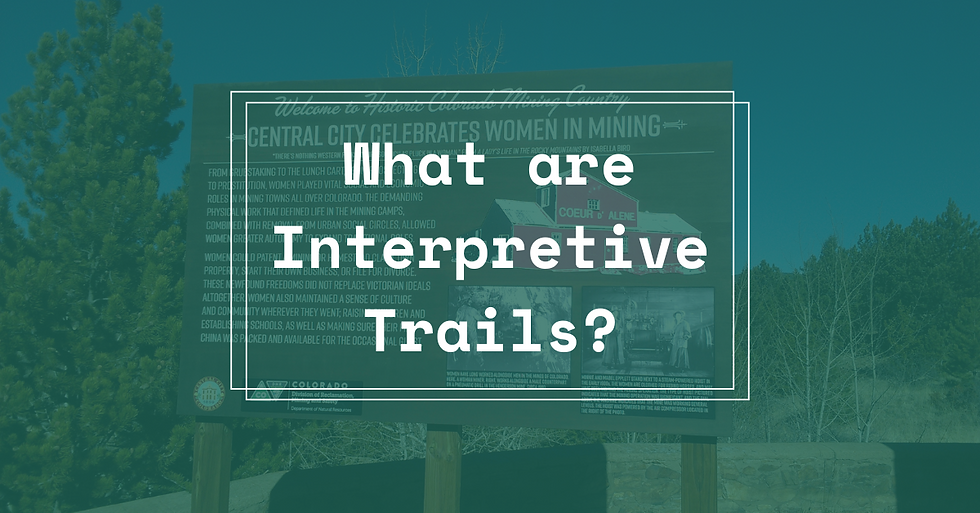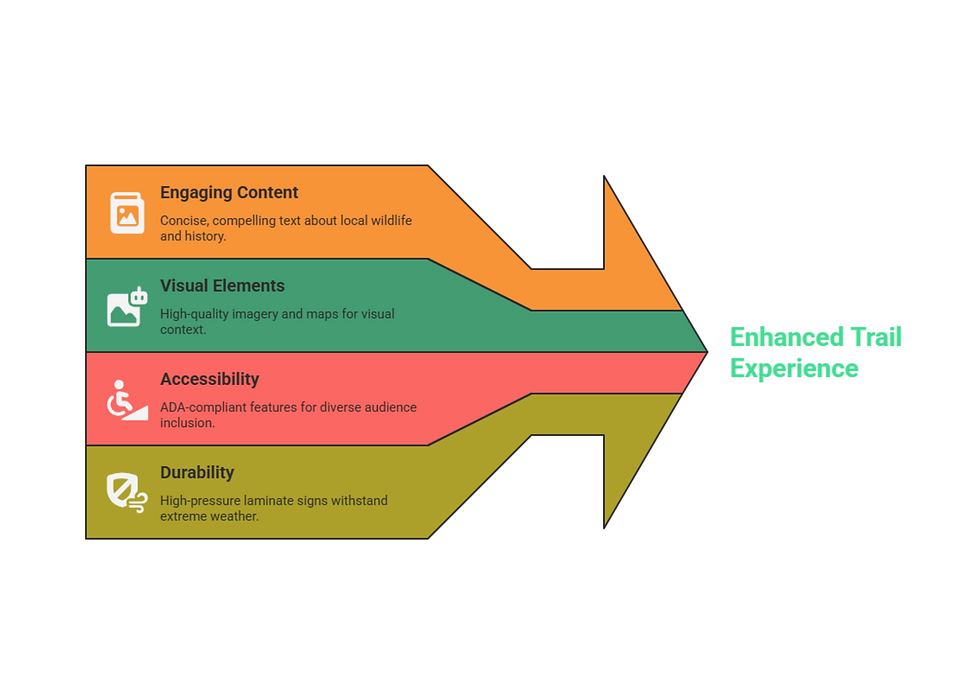What Are Interpretive Trails?
- woodproductsigns
- Jul 31
- 4 min read
Updated: Sep 23

Nature has an incredible story to tell, and interpretive trails are the perfect way to bring that story to life. Through carefully crafted signage and engaging programs, these trails offer visitors a deeper understanding of the environment, history, and cultural significance of the locations they’re exploring. But what exactly are interpretive trails, and how do they work?
If you're investigating signage options for interpretive trails, high-pressure laminate Signs are a reliable and durable solution that can elevate the visitor experience. Whether you're planning an entirely new trail or enhancing an existing one, it’s worth considering interpretive signs for trails to connect visitors with powerful stories that make an impact.
This guide explores everything you need to know about interpretive trails, their significance, and the activities and programs they offer to engage audiences.
What Are Interpretive Trails?
An interpretive trail is a planned pathway designed to educate and inspire visitors. Often located in parks, nature reserves, forests, or cultural heritage sites, they use a mix of signage and interactive elements to help hikers and walkers understand what makes the area special. Whether highlighting woodland ecosystems, ancient ruins, or indigenous culture, interpretive trails aim to keep visitors informed and engaged as they stroll.
Interpretive trail signs are the backbone of these experiences. They often use narrative-driven storytelling to guide visitors along the trail while offering educational content that highlights key points of interest.
Features of interpretive trail signs include:
Engaging Content: Visitors might learn about local wildlife, geological formations, or cultural history through concise and compelling text.
Visual Elements: High-quality imagery, maps, and diagrams provide visitors with visual context and make experiences more memorable.
Accessibility: Many signs are designed with diverse audiences in mind, offering ADA-compliant features like braille or audio components.
Durability: Materials like High Pressure Laminate Signs ensure the signage stays intact, even in extreme weather conditions.
Interpretive signs are an integral tool for making interpretive trails a meaningful experience for everyone.

What Are the Different Types of Trails?
Trails come in various forms to accommodate different audiences, terrains, and purposes. While interpretive trails are one variety, other types of trails also create unique opportunities for exploration.
Nature Trails – Typically focus on the natural environment, highlighting plants, animals, and ecosystems.
Cultural Trails – Showcase cultural and historical landmarks, such as archaeological ruins or sites of significant events.
Hiking Trails – Designed for active explorers, these often prioritize physical challenge over education but can still incorporate interpretive elements.
Themed Walks – Offer specialized experiences, such as bird-watching or seasonal wildflower showcases, often using interpretive signs to tie it all together.
Understanding the variety of trail types ensures the right signage and interpretive strategy to fit the intended audience and purpose.
What Are Interpretive Programs?
Interpretive programs take the concept of trails one step further, offering interactive and immersive activities that bring locations to life. Through storytelling, live demonstrations, or guided tours, interpretive programs connect visitors with the heritage and science of a destination.
Interpretive Program Examples
Here are a few examples of engaging programs that many organizations develop to enhance trail experiences:
Guided Walks – Led by knowledgeable guides, these programs shed light on a trail's history, flora, or fauna.
Cultural Demonstrations – Activities like traditional craft-making or storytelling help visitors experience local culture firsthand.
Historical Reenactments – Actors in period dress bring the past to life at trails located near historic battlefields or villages.
Interpretive Ranger Program
The Interpretive Ranger Program is common in many national parks and protected areas. Rangers work directly with visitors to provide educational tours and programs, fostering a sense of stewardship for the environment. They symbolize both knowledge and connection, especially in locations like Yellowstone or Yosemite, where these programs add extraordinary value to the visitor experience.
Types of Interpretive Activities
Interpretive activities guide visitors beyond the surface experience, fostering curiosity and deeper connections.
Interactive Stations – Touchscreen displays, QR codes leading to digital content, or simple “lift-the-flap” mechanisms encourage engagement.
Custom Interpretive Trail Signs – These are tailor-made to blend seamlessly with the trail’s theme, location, and story. Detailed but approachable, they allow every visitor to enjoy a self-guided, enriching experience.
For example, a trail exploring a local wetland might feature custom signs that highlight the wildlife you might see, explain the ecosystem’s role in water purification, or celebrate the area’s indigenous cultural ties.
Interpretive activities also prompt visitors to reflect on their role in preserving the environment. Whether through hands-on experience or reflective signage, these activities inspire conservation-minded decisions and a new appreciation for the landscape.
Inspire Visitors and Bring Trails to Life
Interpretive trails offer much more than a path or an area's they provide an unforgettable storytelling experience that blends education, inspiration, and engagement. Whether introducing visitors to native wildlife, teaching them about historical events, or connecting them with cultural heritage, interpretive trails leave a lasting impression.
Whether you’re designing fresh signage or replacing outdated elements, consider the durable and visually striking benefits of high-pressure laminate Signs to make your interpretive trail stand out. Explore our solutions for creating custom designs that meet your trail's unique needs and aesthetic.
Want to learn more about enhancing your trail with interpretive signs for trails or developing custom signage? Request your quote today or contact our team now to get started on signage that elevates every step of the journey.





Comments